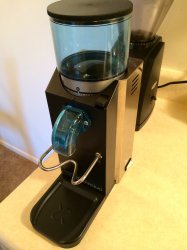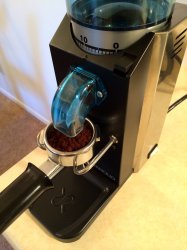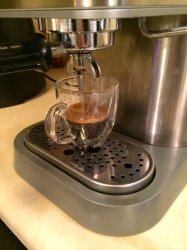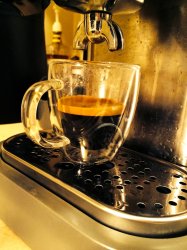I thought I should come back and post a few roasting tips. I will shy away from the stuff you will read on SM.
1. Speaking of SM, they have excellent tutorials. Start there.
2. Figuring out when FC starts or ends or SC starts can actually be a bit intimidating at first. A good rule of thumb to remember is to ignore any cracks that are not followed or preceded by another crack within five seconds. Almost always, for example, you will hear a stray early crack by some impatient bean, so, if the "real" first crack starts at 5:00 (counting down, for me, from 17:00), you might hear a stray crack one minute earlier, at 6:00. Ignore it. Same thing on the tail end. Only cracks that are within 5 seconds of another crack count (although I follow this rule a bit less doggedly for second crack than first, but you will figure it out after just a few roasts).
3. Start a log. Write down everything. Number your batches. I suggest you track at least:
. roast batch (I number them, by year then sequential number)
. date
. time of day (my evening roasts taste better than early morning roasts, no idea why).
. a general comment on humidity, ie "raining outside." I do not record the exact measurement; many roasters do.
. my goal roast, so "second crack + 45 seconds" or "Vienna" or the like.
. which roasting profile I am using (I keep a separate spreadsheet with all of my roasting profiles; with the date and the profile number I can always go back and see exactly what parameters I used). Even with an air popper, I think you will benefit by keeping track of this (and with your science background you probably will anyway). So, start with your first roast and figure out a profile, call it "MobileH1" or whatever, and then you will tweak the parameters going forward.
. pre-heat time/temp
. time FC begins
. time of rolling FC
. time FC ends
. time SC begins
. time SC ends
. eject time
. stretch time (this is to record my manual adjustments to the parameters during the roast process, basically I reduce the heat to below the bean temperature as soon as FC ends, and then I crank the heat back up to above the bean temperature exactly 2 minutes later....this is my attempt to extend the period between FC and SC as much as I can).
4. I think it's a good idea to keep tasting notes for each batch. Over the years, I have used both simple (just a simple numerical grade, 1-100) and complex. Currently, I am using a simplified version of the
SCAA cupping form.
I learn a lot by going over data on past roasts and cupping scores.
5. SM will tell you to pay serious attention to cooling the beans. Listen to them; beans are just like a steak on the grill, they continue to cook after you remove the heat. At a minimum, get two colanders and pour the just-ejected beans back and forth until they are not warm to the touch.
6. Chaff. I'm not exactly sure how to deal with chaff in an air popper, but read up on this. It's important. You will be surprised, I think, how much chaff even a small volume roast can produce. It's a bit hard to see, but this picture is the chaff produced tonight by a 227g roast of Liquid Amber. The last thing you want is to ruin your cup by grinding up a bunch of chaff. The colanders will help, but are not a complete solution.
Image
Most of all, have fun!







